By Walter Sorochan
Posted December 12, 2011.
This article provides information about how the mining industry has changed in the past 30 years and how new microbe technology will help us to keep the environment clean.
[ En las siguientes páginas daremos un vistazo a las principales tendencias que están marcando el futuro de la minería latinoamericana a través de la innovación, desde las faenas de exploración hasta el cuidado medioambiental, pasando por la ingeniería de minas y los procesos de recuperación de los metales. Espanol: el futuro de la minería latinoamericana/el mundo ]
The Abandoned Mine Problem
There are tens of thousands of abandoned mine sites around the world that contain mining-related arsenic and other hazardous substances. The effects of such pollution include polluted water, contaminated land, air pollution, loss of useful groundwater and land, and significant negative health consequences to humans and animals living in the area. More than a century of mining has left many areas around the world filled with highly-toxic materials and known carcinogens.
The issue is so widespread across the globe, and has been going on for so long, that the exact extent of the contamination is unknown and a complete list of affected sites remains unavailable. Studies of various geographic locations and anecdotal evidence, however, provide a robust understanding of the contamination and public health problem.
According to the US Environmental Protection Agency, there are approximately 420,000 abandoned mines, over 13,000 of which are categorized as "abandoned mines with potential environmental hazard," in the states of California, Arizona and Nevada alone. Muller Robert: POLLUTION: Abandoned Mines, Acid Mine Drainage, and the Promise of Bioleaching June 27, 2009
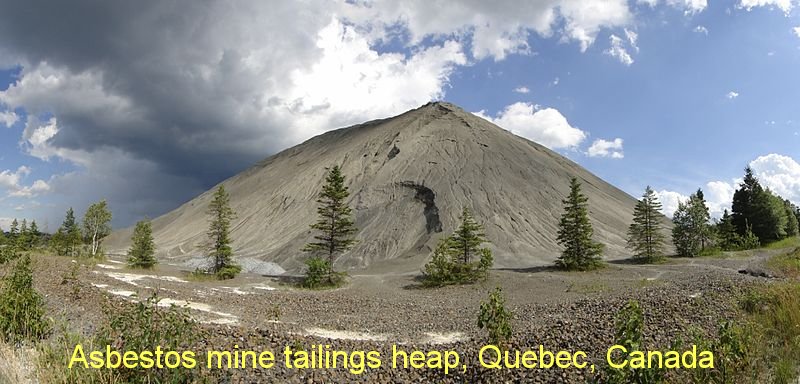 A major problem of mining in the past came from leftover materials, referred to as
mine tailings. [ waste heap in photo on right ] Mine tailings are waste materials brought up from the mines and discarded
in piles or big heaps after the
ore was extracted. The gigantic mounds, over time, became toxic and poisonous to plants, animals and
people. World
mining hazards
Fischer: benefits bioleaching
A classic example of toxic mine waste heaps pollution are the Asbestos mine
tailings heap in Quebec, Canada [ photo above on right ] and the Atlas uranium mine
leakage of toxic chemicals into the Colorado river near Moab, Utah. Atlas Mine Uranium Project History
Adding to the toxic wastes of mining companies have been the piles of industrial wastes
found in junk yards and garbage dumps all over the world.
A major problem of mining in the past came from leftover materials, referred to as
mine tailings. [ waste heap in photo on right ] Mine tailings are waste materials brought up from the mines and discarded
in piles or big heaps after the
ore was extracted. The gigantic mounds, over time, became toxic and poisonous to plants, animals and
people. World
mining hazards
Fischer: benefits bioleaching
A classic example of toxic mine waste heaps pollution are the Asbestos mine
tailings heap in Quebec, Canada [ photo above on right ] and the Atlas uranium mine
leakage of toxic chemicals into the Colorado river near Moab, Utah. Atlas Mine Uranium Project History
Adding to the toxic wastes of mining companies have been the piles of industrial wastes
found in junk yards and garbage dumps all over the world.
A New Approach to Mining
In the past 20 years there is a new technology that does the same metals extraction as the old mining systems but it does not pollute or poison plants, animals and people. The new process is bioleaching or bio-mining. Fischer: benefits bioleaching The traditional ways of mining metal ores --- excavation, crushing and smelting, helped to extract metals like iron, copper and gold. These processes created a lot of polluting dust, gases and toxic chemical compounds. Now these processes are being replaced by invisible, less polluting and less expensive mining technology. This new mining technology is being adapted to many other industries, like getting oil and gas from oil shale sands in Alberta. For more information using new technology to get oil from shale
The new mining technology, bioleaching, is explained by video below: Invisible miners Part III 9 mns.
What is Bioleaching
Nature has its own slow process of breaking down the ore over many, many years by changing the acid chemistry of the ore. This chemical change activates natural bacteria in the ore. The result is a slow decomposition of the ore, releasing sulphuric compounds that, in turn, also release metals into the environment. This releasing of chemicals from ore is referred to as natural biological leaching.
Commercially applied bio-leaching technologies utilize the same phenomenon, but accelerate this natural process. Air temperature, oxygen, water, acidity and different bacterial populations are manipulated in a controlled environment so as to accelerate bacterial freeing of metals from the ore. This process is referred to as leaching.
Bioleaching uses billions of rock-eating bacteria, acting as catalysts, to extract iron, gold, silver, cobalt and other metals from century-old mining waste. This process converts the insoluble metal sulphides in mine wastes into water soluble metal sulphates, thereby neutralizing the toxins like sulfphur and arsenic. The process is engineered to control the environment in which acid bacteria can speed up the breakdown of insoluble sulphides into soluble sulphates.
Biochemistry of bioleaching
In the chemistry of the bio-mining or bioleaching process: microorganisms catalyze [ speed up the reaction ] the oxidation of ferrous iron and sulphur, to produce ferric iron and sulphuric acid:
Fe2+ + 1/4O2 + H+ ---> Fe3+ + 1/2 H2O
S + 3/2O2 + H2O ---> H2SO4
The ferric iron reacts with mineral sulphides [MS] to produce ferrous iron and sulphur as illustrated in the following reaction:
MS + 2Fe3+ + M2+ + 2Fe2+ + S
Acid thriving bacteria, naturally growing in the ore, are activated by water, oxygen and warm temperature. This conversion of rock-ore by nature's bacteria to acid sulphur takes two to five years in the open pit field.
The bugs produce ferric iron (Fe3+), a powerful oxidizing agent, and sulphuric acid as by-products. Conveniently, ores featuring metals such as copper, zinc, uranium, cobalt or gold often contain iron ore that are sulphides, or they co-exist in deposits with such substances. Iron and sulphur have no commercial value in these ores but by liberating them, the bacteria also liberate the more valuable metals. Evans: mining bugs
Metals in the form of dissolved salts, such as copper sulphate, can be recovered easily in subsequent electrolytic or chemical processes. Gold and silver remain inert as pure metals but are exposed by the oxidization of the surrounding material and recovered by mixing the oxidized metal-bearing solids with lime to raise the pH, and then applying standard methods for precious metal recovery.
Bacterial metal extraction techniques have been used since the mid-1980s to extract gold from refractory ores not readily processed by any competing technology. In this case, the bacterial cultures are set to work in huge stirred tanks, called bioreactors, containing a slurry of ore concentrates and dilute sulphuric acid. Cobalt has also been recovered in bioreactors in Uganda recently, but generally this technology has struggled to compete with more established methods for processing mineral concentrates such as roasting and smelters where the infrastructure already exists. Evans: mining bugs More recently, many other metals, including oil from shale, are now being successfully extracted by bioleaching.
Benefits of bioleaching:
In addition to stabilizing toxic pollution, the new technology
also recovers precious and base metals from tailings for sale, making the
technology a profitable environmental remedial solution:
Disadvantages of using bioheaps Knoll: biomining
Traditional Mining procedure
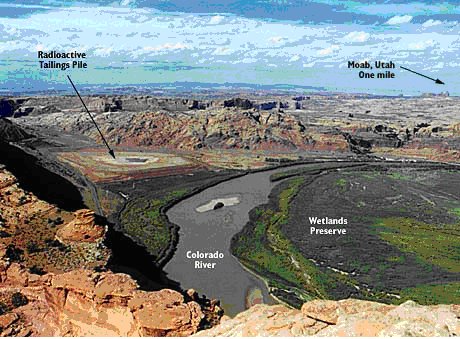
Before being mined, the acid-bearing rock was sitting safely in the ground with a
very small surface area in relation to its volume, so very little acid was
produced.
As long as the rock was undisturbed, very few toxins were emitted.
But when the sleeping ore rock is awakened by digging the rock containing ore,
and then crushed into talcum powder consistency [ making it easier to extract
ore ], the acid formation begins in the presence of water and air! After the ore was removed from the
powder-rock ore, the remaining waste or tailings [ retaining other metallic ores
] would be dumped on large piles or "heaps" of land referred to as bio-heaps. A
good example of reckless mining procedure is the uranium tailings mine adjacent
to the Colorado river near Maub, Utah, photo on left. The uranium wastes from
the tailings pile have been leaking into the Colorado river.
 Another example, 90% of copper ore is mined by open pit. The flow chart on the right shows you how copper has been traditionally
extracted from its ore and converted into pure metal. The ore is a mixture
of minerals and rock [ called gangue ].
Copper mining traditionally
Another example, 90% of copper ore is mined by open pit. The flow chart on the right shows you how copper has been traditionally
extracted from its ore and converted into pure metal. The ore is a mixture
of minerals and rock [ called gangue ].
Copper mining traditionally
Although the left-over sulphur rock-powder greatly increased the surface area, making it easier to extract the ore from the rock, it also exposed the tailings to rain or nearby water, allowing sulphuric acid to form immediately. To contain the sulphuric water, mining companies would build storage or holding ponds that were usually [ but not always ] sealed with clay liners. As long as the seal remained intact the acid forming mine tailings would be “safe.” Unfortunately, many holding ponds would break or leak; water from pond storages would leak into nearby soil, poisoning the soil and environment.
The holding ponds have remained a potential danger until the discovery of new bio-mining technology.
Reclaiming mine wastes
Currently, the U.S. Bureau of Land Management (BLM) indicates that there are over 31,000 known abandoned mine sites on U.S. public lands alone. Alvorado: bacteria cleans old mines These include a variety of mines: coal, aluminum, copper, gold, silver, uranium and many more; including oil and gas fields.
The number one problem in North America and obviously South Africa and South America is Acid Mine Drainage [AMD]. Sulphides are sitting in the mine tailings, exposed to wind, rain and sun. There they start to oxidize, creating a sulphuric acid, which then makes its way out of the tailings, kicking up and liquefying heavy metals. In the process, this acidic solution leaches heavy metals into nearby sources of groundwater that eventually make contact with watersheds, soils and vegetation. Alvorado: bacteria cleans old mines
The metals may then get dumped into a local river, which changes the pH of the water in a critical way. In the US, the state of Pennsylvania is the largest generator of acid because of coal tailings that have been left behind a hundred years ago, laying there for ages, poisoning the water and the environment. Fischer: benefits bioleaching
Another conventional practice in the mining industry has been to treat the water discharge from disposed tailings or build a holding dam around them. Both of these approaches have failed to prevent waste mine pollution. Alvorado: bacteria cleans old mines
Two basic bio-mining strategies
There is renewed world interest in using bioleaching technology to reclaim old mine tailing heaps. Basu: bioleaching in coal mines Miller: biomining in China Holder: bioleaching heaps Riekkola: biomine in Arctic Fischer: benefits bioleaching Chavez_Crooker: Bioleaching Chile Hicks: Big mine Canada bioleaching: Finland Joy: New Zealand river poisoning Neale: gold recovered S Africa RebGold: future of bioleaching
A Finish mining company, Talvivaara, began in 1980, to develop a multi-heap bioleaching system to reclaim metals. This system is built at the site of the metal rock location. More on this bio-mining system later on. This bioleaching process, using natural bacteria to extract metals from the numerous ores, takes 2 to 5 years.
The other strategy is to use bio-leaching to extract metals from heaps of left over and aging mine wastes, as exemplified by BacTech and other bio-mining companies. This is done by building a bioleaching system directly at the waste heap site. Depending on the design of this bio-leaching system, this process can take 3 to 10 days to extract various metal ores from the crushed rock.
Talvivaara:
The process flow in Talvivaara consists of four main steps in an open pit mine: mining, crushing, bio-heap-leaching and metals recovery. Crushing is done in four stages, followed by agglomeration with PLS solution in order to consolidate the fines with coarser ore particles. The plant bio-heap site is diagramed below:
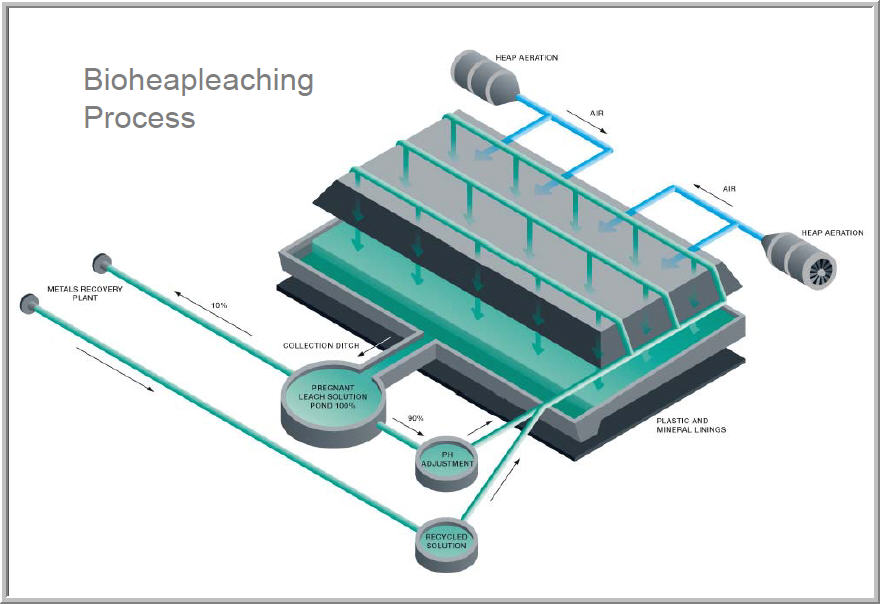
Bio-oxidation heaps – engineered heaps are formed by stacking crushed rock into constructed piles on prepared impervious pads that have a sloped base to allow the liquid solution to flow by gravity into collection drains. Oxygen can be added to the system to enhance the rate of oxidation by blowing low pressure air into the heap base. This system was first employed for secondary copper minerals in large dumps using run of mine ores. Acidic solutions carry away the bio-oxidized products such as copper or iron. Recent advances in whole ore heap leaching have seen the use of closely sized ore particles to aid the oxidation rate, under heap piping for better air distribution and agglomeration, and pre-inoculation to aid in permeability and oxidation rate. Holder: bioleaching heaps
Additionally, whole ore systems are now applied to a wide range of ore types including refractory gold ores, copper sulphides, nickel sulphides, cobaltiferrous ores and zinc sulphides. Companies such as GeoBiotics, Newmont and Titan Resources all have various technologies for whole ore bio-oxidation. Holder: bioleaching heaps
BacTech: [ RebGold ] a Canadian clean tech company, has harnessed bioleaching to deal with waste mine pollution. In this type of process for treatment of chalcopyrite concentrates, the material is finely ground and fed continuously into a series of agitated aerated temperature controlled reactors containing the bacteria. Bacteria accelerate the breakdown of minerals. The residence time used, of between 4 to 6 days, is common to similar bacterial processes used in the gold industry. After separation of the oxidized residue, copper is then extracted from the liquid by conventional solvent extraction and electrowinning technology. Iron (and if necessary arsenic) is rejected from the liquid by neutralization with limestone to give a stable solid of ferric or ferric arsenate for disposal which meets the strictest environmental requirements. BacTech clears abandoned mine sites. Fischer: benefits bioleaching RebGold: future of bioleaching
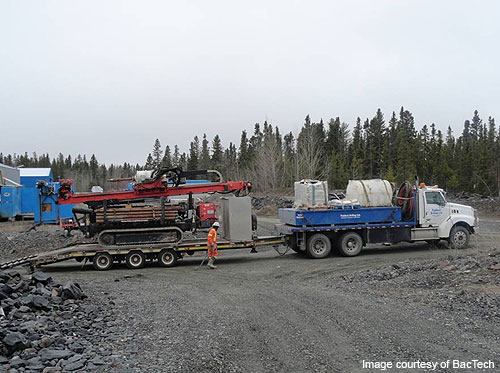 In case of tailings, BacTech
can go to the site and refloat the tailings to make another concentrate. And the bacteria don't care - as long as they have sulphides to get their energy from they are going to continue to attack for sulphides and liberate the metals for recovery.
In case of tailings, BacTech
can go to the site and refloat the tailings to make another concentrate. And the bacteria don't care - as long as they have sulphides to get their energy from they are going to continue to attack for sulphides and liberate the metals for recovery.
The BacTech bio-mining system uses tanks, where the bacteria oxidize the sulphides within optimal operating and living conditions. [ photo below of BioTech gold recovery plant BacTech: cleaning mine left-overs ] At the beginning the system may use five or six tanks; but by the time the process gets to the end there may be two settling tanks. One tank has a pregnant solution of base metals such as zinc, copper, nickel. The bacteria create sulphuric acid in the tank by oxidizing the sulphides. When sulphuric acid touches the base metal, the metal liquefies and then the base metal is recovered using conventional technology such as electro-winning.
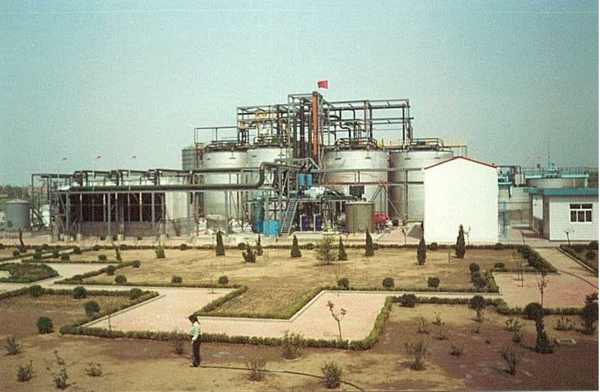 The other tank will have the precious metals, which are basically residues and the stuff that has not been devoured.
Technicians take that residue and just put it back into a conventional gold circuit to recover the metal.
The other tank will have the precious metals, which are basically residues and the stuff that has not been devoured.
Technicians take that residue and just put it back into a conventional gold circuit to recover the metal.
The nice thing is that the bio-mining system doesn't have to separate the concentrate into copper, zinc and gold; instead the recovery process puts everything into the same tank and removes metals in various stages along the way; much like gasoline and other petrol products are distilled from crude oil. Fischer: benefits bioleaching
Types of bacteria used? Riekkola: biomine in Arctic Fischer: benefits bioleaching
There are as many as 60 different bacterial strains that can be used.
Conclusion:
Bioleaching is a rather new technology that has been changing rapidly since 1980. It is being used world wide to reclaim metals from abandoned old mine wastes and to also remove poisonous chemicals from old mine areas. Bioleaching can be thought of as the acceleration of a natural environmental process using naturally occurring organisms that leach or separate sulphide minerals from ore. Currently, companies are using bioleaching for ore treatment in heap leach operations, and for the future treatment of copper and other metal concentrates by bioleaching in agitated reactors. RebGold: future of bioleaching
The technology is being adapted, with limited success, to new mining ventures as in the oil-shale deposits in Lake McMurray, Alberta, as well as reclaiming depleted oil wells and also reclaiming numerous metal mines. Yen: bioleaching shale into oil Meyer: bioleaching for oil in shale Future application of bioleaching technology may also help solve the accumulation of wastes in junk yards, garbage dumps, sewage treatment plants and water purification plants. Mishra: current research bioleaching All that is needed is political support, innovation and imagination!
For more health information: Go to main menu
Feedback to author: E-mail
References:
Alvorado Oscar, "Mining Safety: Bioleaching Bacteria Clean Toxic Mine Tailings," Global Mining, April 5, 2011. Alvorado: bacteria cleans old mines
Basu Ankan, Marshall Miller and Associates, "Thiobacillus ferrooxidans and Coal Mining: A Faster Way of Producing Acid Mine Drainage," Coal Geology, April 20, 2011. Basu: bioleaching in coal mines
Bioleaching plant commissioned in China." July 13, 2001. China bioleaching 2001
2000: A Chinese company, Shandong Tarzan Biogold Co. Ltd. ("Biogold"), licenses and installs a bioleach plant capable of treating 100 tonnes of concentrate per day from mines both in China and abroad, demonstrating the diversity of the technology for treating non-homogenous feeds from various metallurgical backgrounds. Recently, the current owner, Sino Gold Mining Limited, doubled the capacity of the current plant to 200 tonnes per day.
BacTech also REBgold Corporation, "Mining solutions for a greener planet," BacTech, December 2010 BacTech: cleaning mine left-overs
Chavez-Crooker Pamela, "AguaMarina SA Chile, Aguamarina, December 2010. Chavez_Crooker: Bioleaching Chile
Copper mining traditionally, Copper mining traditionally
"Environmental Impacts of Mining and Smelting," Occupational Knowledge International, World mining hazards
In 2010, more than 400 children died in Zamfara, Nigeria, from acute lead poisoning caused by unsafe mining and processing lead-containing gold ore. People grinding the ore, often in and around their homes, contaminated at least 180 villages over a wide area.
Evans-Pughe Christine, "The mining bug: hunting metals with bacteria," Engineering and technology magazine, vol 5 issue 15, October 4, 2010. Evans: mining bugs
Fischer Elizabeth, "Toxic Mines: Benefits of Bioleaching Bacteria," Mining technology, June 23, 2011. Fischer: benefits bioleaching
Hicks Brian, "Massive Mine in Canada," Energy and Capital, September 20th, 2011. [ Alberta Black Shale Project ] Hicks: Big mine Canada
History of Atlas Mine Uranium Project, Atlas Mine Uranium Project History
"The Atlas site is the fifth largest uranium tailings pile in the U.S. and by far the most dangerously polluting. This facility extracted yellowcake uranium for nuclear bombs and reactors from ores trucked from over 300 mines on the Colorado Plateau. The slime-like wastes from the mill, laced with radium, uranium, thorium, polonium, ammonia, molybdenum, selenium and nitrates, were slurried into an unlined pond in the floodplain of the river. As more capacity was needed, contaminated soils were bulldozed up to raise the sides of the tailings impoundment. By 1984, when the mill was put on standby, this pile of mill wastes had grown to 16 million tons, covering 130 acres to a depth of 110 feet."
Holder Nick, Tracey Stanek, Todd Harvey, "Types of Bioleaching Technologies Available," BioMetMine, Holder: bioleaching heaps
Invisible miners video. bioleaching: Finland
Johnson D.B., " Biodiversity and interactions of acidophiles: Key to understanding and optimizing microbial processing of ores and concentrates," Science press, November 05, 2008. Bangor University, Bangor, Australia. [ Trans Nonferrous Met. Soc, China 18, 2008 ] Johnson: understanding bacteria recovering ores
Joy Mike, "An acid trip for NZ rivers," Forest and Bird, March 31, 2010. Joy: New Zealand river poisoning
Kubach Charles, "Gold Cyanide Solution (Leaching Gold With Cyanide)," Chemistry of Cyanidation, American Cyanamid. Kubach: cyanide leaches gold
Meyer W. Craig and T. F. Yen, " Enhanced dissolution of oil shale by bioleaching with thiobacilli," Applied and Environmental Microbiology, October 1976, Vol 32, No. 4, p. 610-616. Meyer: bioleaching for oil in shale
Miller P., F. Jiao, J. Wang, "The bacterial oxidation [BACOX] plant at Laizhou, Shandong provine, China - The first three years of operation," Presented to Bac-Min conference, November 8-10, 2004, in Bendigo, Australia. Miller: iomining in China
Mishra Debaraj and Young-Ha Rhee, "Current research trends of microbiological leaching for metal recovery from industrial wastes," Current Research, Technology and Education, Topics in Applied Microbiology and Microbial Biochemistry, 2010. Mishra: current research bioleaching "Bioleaching to be applied to industrial wastes and new microbes will need to be identified.
Mining Innovation in Latin America, Espanol: el futuro de la minería latinoamericana/el mundo
Neale John, "Bioleaching technology in minerals processing," Mintek, Biotechnology Division, Randburg, South Africa. September 2006. Neale: gold recovered S Africa
RebGold, "Bioleaching of Chalcopyrite for Copper - The Future," REBgold Corporation, 50 Richmond Street East, Suite 300, Toronto, Ontario M5C 1N7. RebGold: future of bioleaching
Riekkola-Vanhanen Marja, "Talvivaara Sotkamo mine - bioleaching of a polymetallic nickel ore in subarctic climate," Nova Biotechnologia, 10-1, 2010. Riekkola: biomine in Arctic
Talvivaara Mining Company, "Metals recovery: Talvivaara relies on bioheapleaching and metsoDNA," Metso, Finland, Talvivaara: metals revovery Talvivaara: what is bio-mining
Yen Fu Teh, Milo Don Appleman and John Eugene Findley, "Method of converting oil shale into a fuel," United States Patent # 2,982,995, Sept 28, 1976. Yen: bioleaching shale into oil